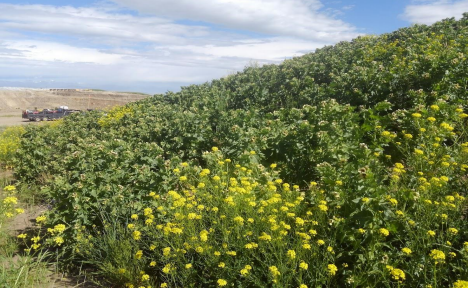Seed Mix Design: Ecology and Function versus Permitting and Compliance.
In previous MSC Quarterly articles we addressed the basics of seed mix design. From an ecological and functional perspective, grasses, forbs, and shrubs included in a seed mix have a purpose. The design may lead to revegetation that protects soil from erosion, enhances wildlife habitat, reduces wildfire risk, inhibits noxious and nuisance weeds, or serves agricultural production objectives. Private landowners can specify plant species that meet their objectives, climatic conditions, and cost constraints. Large projects are regulated by local, state, or federal authorities. They may require seed mix design elements that conflict with ecological and functional objectives to obtain an approved agency permit or plan. Examples are presented.
Consider wildland projects including mining, timber harvest, burned area restoration, wildlife habitat improvement, and road construction. Conventional wisdom would dictate the use of an adjacent undisturbed part of the landscape as a “reference” for plant species that should be included in the seed mix. Unfortunately, many projects are constrained by lack of understanding by the permitting entity, or obligations to use antiquated “approved” seed mixes.
For example, our recent mine work is reclamation of exploration drilling sites located on Bureau of Land Management administered land in Montana. Guidance from BLM 3809.420 regulations require “revegetation of disturbed areas, where reasonably practicable” and “rehabilitation of wildlife habitat”. The project-specific BLM and MDEQ permits required the inclusion of Dutch White clover in the seed mix, a non-native highly invasive legume. The project proponent was required to use Dutch White clover on a remote mountain landscape located next to a BLM Wilderness Study Area. Or postpone reclamation to re-permit.
The Montana Department of Environmental Quality (MDEQ) has administrative authority over mining and milling projects on private lands. Our recent revegetation efforts on mill tailings impoundment berms required the use of an existing MDEQ-approved seed mix. The impoundment berms were located along an active railroad track and adjacent to several warehouse buildings. The approved seed mix included intermediate wheatgrass, a non-native, high yield pasture grass that grows 4-feet tall in southwestern Montana. It produces roughly five tons per acre annually. The approved seed mix would have created an increased fire hazard. Two years passed before the project was seeded, after the MDEQ finally re-authorized a revised seed mix that consisted of very short stature grasses and forbs.
Another recent Montana mine reclamation project was constrained by a 20-year-old MDEQ approved final reclamation seed mix that included yellow sweet clover and crested wheatgrass. From an invasive species perspective, the yellow sweet clover is a very aggressive and rapidly spreading, highly undesirable species. The extensive use of crested wheatgrass conflicted with any attempt to return the range landscape to a native vegetative community. The project proponent used the relict seed mix rather than wait many months for a permit revision.
Our new solar project is in an area that receives about 6 to 8 inches of annual precipitation. The project area sustains blue gramma, Idaho fescue, prickly pear cactus, and rabbit brush. The project proponent proposed revegetation with a generic dryland pasture seed mix consisting of intermediate wheatgrass, orchard grass, smooth brome, and crested wheatgrass. Our county officials basically approved “hay” for the solar project revegetation seed mix.
We are currently permitting gravel pit reclamation for an interstate project. New MDEQ Non Sage Grouse/Sage Grouse Habitat Seed Mix Guidelines (2022) apply, although it lies on the
edge of both “General” and “Interconnectivity and Core” Habitat areas (GICH). The new guidelines for GICH require complete compliance with region-specific seed mixes, application rates, and seeding methods; regardless of existing plant species, rationale for alternate seeding rates, or seed cost and availability. The guidelines do allow for alternatives if “a baseline vegetative study is completed by a vegetation specialist using accepted sampling criteria”.
Montana mining reclamation practices are regulated by USFS, BLM, and the MDEQ. Historic performance criteria required 75% revegetation of “Site Potential” within three years of final reclamation. Currently the MDEQ SWPPP revegetation compliance criteria is “A minimum requirement is 70% of pre-disturbance levels uniformly distributed throughout the area of disturbance …. within 2 to 5 years depending on site factors”. The MDEQ does not discriminate between nuisance weeds and favorable vegetation. MDEQ often defers to local requirements of conservation districts and county weed programs to manage noxious weeds.
In Colorado, most agencies have standards that require 70% of disturbed ground to be revegetated. “Disturbed areas must be seeded, planted, or otherwise managed to reestablish a cover of beneficial plants”. The Colorado Oil and Gas Conservation Commission requires 80%.
In conclusion, one may use good science, seed technology, and practical experience to prepare an effective seed mix for a specific project. In many cases, regulatory or other constraints may impose revegetation requirements that are undesirable or time consuming to re-permit. Best professional judgement and site-specific knowledge does not always prevail.

Black Henbane: A “Watch List” species but not “Noxious”. Does this meet your revegetation standards?
Prepared By John Whittingham, CPESC, PWS, IECA MSC Board Member and Montana Representative, Co-Owner Basic Biological Services LLC, Dillon, Montana, info@basicbiologicalservices.com
